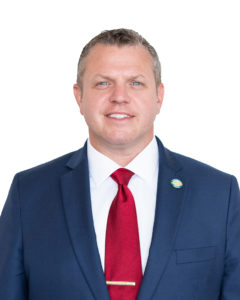
Commissioner Jason E. Glass
I like to say that people who are drawn to becoming teachers generally have a calling. That got me thinking; why do we often call teaching a calling?
I can think of a couple of other professions that use that same term, like people in the medical field or religious leaders. The more I thought about it, the more I saw that it makes sense. Each one of those professions focuses on caring for someone, whether it is patients, parishioners or pupils.
Although I find my job as Kentucky’s commissioner of education challenging and deeply gratifying, I must say that I miss the classroom. I miss building relationships with my students and seeing each one of their unique gifts develop.
I’m not alone in believing that education is a calling. Scott County’s Erin Ball, the 2020 Kentucky Teacher of the Year, went into teaching because of a 2nd-grade teacher who instilled an early love of reading in her that she wanted to share with others. Ashley Lamb-Sinclair, the 2016 Kentucky Teacher of the Year, found herself drawn to education because of a 3rd-grade teacher who sparked her lifelong curiosity and passion for learning, which gave her a path out of poverty. How many other professions give you a chance to make that big a difference in the life of a child?
While educators are given the wonderful responsibility of helping to shape the future of the Commonwealth by serving the children of today, we have too few people wanting to become educators and too many educators leaving the field shortly after they start. We especially have too few men, people of color and individuals from lower-income backgrounds currently in the teaching profession.
During the 2019-2020 school year, about 25% of students identified as a race other than white, while only about 5% of our teachers identified as non-white. Almost 61% of our student population last school year was considered economically disadvantaged. While we don’t have numbers about how many of our teachers come from disadvantaged backgrounds, I’m willing to bet it’s nowhere close to 61%.
It’s important for our students to see people who look like them at the front of a class, whether we are talking about race, ethnicity, economic background, disability or gender. When students see a teacher that looks like them or shares their background, they tend to do better in the classroom and have lower dropout rates.
The future of our teaching workforce is looking brighter. Enrollment in Kentucky’s Teaching and Learning Pathway – which gives valuable experience and training for our future educators while they are still in high school – is more diverse than the current general student population. In the 2019-2020 school year, 28% of the students participating in the pathway were non-white, while the student population was just under 25% non-white.
Students interested in becoming educators also can join Educators Rising, a career and technical student organization for middle and high school students that helps them build resources and experiences that can benefit them when they have their own classroom.
And if you are an adult who is looking for a new career or if you have always thought about teaching, now is a great time to making that dream come true. Through the Kentucky Department of Education’s GoTeachKY initiative, you can explore what being an educator is about and find resources to help you get started.
Short of being a husband and a father, teaching has been the most rewarding experience of my life and I am thankful every day for the opportunities it has afforded me. So, if you’ve ever felt the calling to be a teacher, now is the time to explore that option. Teaching gives you an opportunity to do something that truly makes a difference. You too can teach a child and change a life.



Leave A Comment